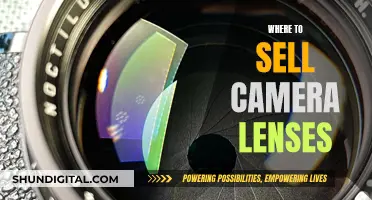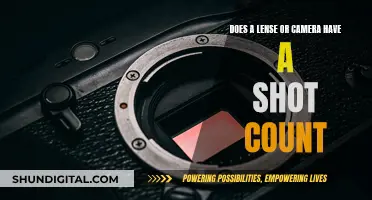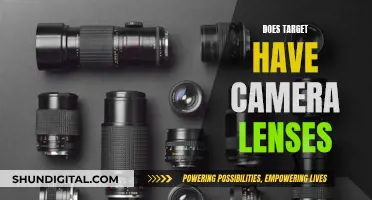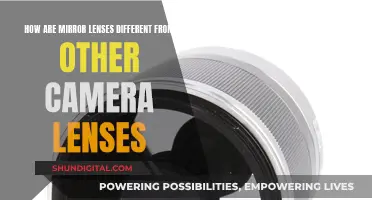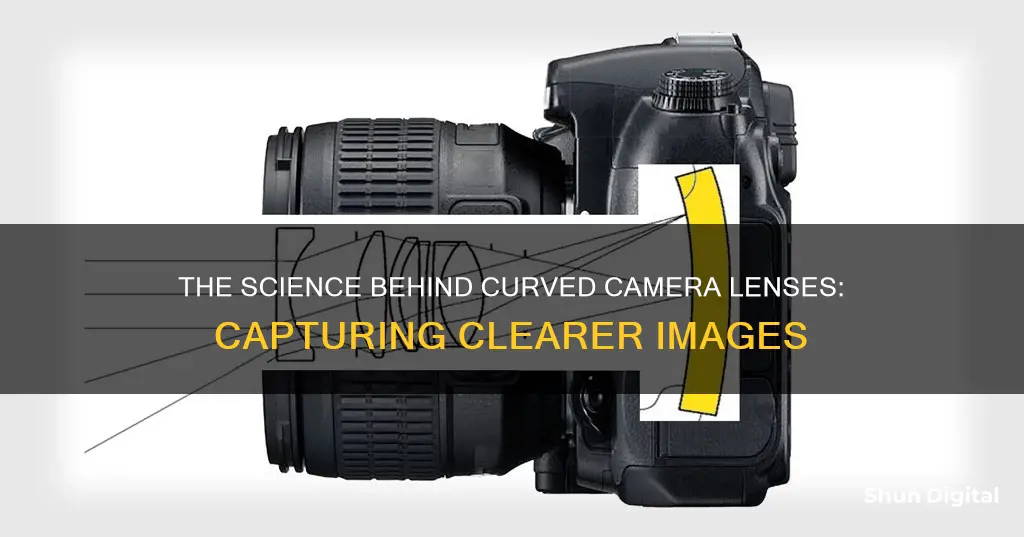
Camera lenses are curved to capture images in a way that presents a more familiar visual perspective to the human eye. This is because the human eye has a curved lens, which causes light to refract in a way that presents an image to the retina that is curved, rather than flat. A curved lens in a camera mimics this effect, and allows for a more accurate representation of the image being captured.
What You'll Learn
- Camera lenses are curved to counteract the effects of field curvature, which causes images to appear sharp only in certain parts of the frame
- Curved lenses can help to create a spherical field of focus, which is useful for portrait photography
- Curved lenses can also be used to create a fisheye effect, which is often used for artistic purposes
- The curvature of a lens can impact the depth of field, with curved lenses often providing greater isolation of the subject
- Curved lenses can reduce focusing errors when using the 'focus and recompose' technique in photography

Camera lenses are curved to counteract the effects of field curvature, which causes images to appear sharp only in certain parts of the frame
Camera lenses are curved to counteract the effects of field curvature, which is a common optical issue that causes images to appear sharp only in certain parts of the frame. Field curvature occurs because the image is projected in a curved manner, but the camera sensor is flat, so it cannot capture the entire image in perfect focus. The result is that the centre of the image may be in focus, but the sharpness decreases towards the edges of the frame.
The curvature of camera lenses helps to ensure that objects at the periphery of the frame, which are in the same plane as the subject, can also be in focus. This is particularly beneficial for portrait photography, where it is common to blur the background while keeping the subject sharp. The curved lens allows for a spherical field of focus, which can provide more pleasing bokeh blur for background objects near the edges of the frame.
Additionally, a curved lens can improve the accuracy of focusing when using the "focus and recompose" technique. When the camera is rotated around its optical centre, a spherical field of focus will keep the intended point of focus sharp, whereas a flat field of focus would result in the focus point moving behind the subject.
It is worth noting that while a curved lens can improve image sharpness in certain scenarios, it is not a perfect solution. Field curvature can still vary by distance, with some lenses exhibiting stronger curvature at close distances or infinity. Additionally, different types of lenses, such as telephoto lenses, typically have less visible field curvature than wide-angle lenses.
Signed Camera Lenses: What's Their Fate?
You may want to see also

Curved lenses can help to create a spherical field of focus, which is useful for portrait photography
Camera lenses are curved to combat the optical problem of field curvature, also known as "curvature of field" or "Petzval field curvature". This issue causes a flat object to only appear sharp in parts of the frame, rather than uniformly sharp across the whole frame. This is due to the image being projected in a curved manner, which cannot be captured in its entirety by flat digital camera sensors.
The use of curved lenses can also reduce focusing errors when using the 'focus and recompose' technique. This is because the focus point will remain where intended when the camera is recomposed, as long as the camera is rotated around the optical centre of the lens.
However, it is important to note that the effect of curved lenses can vary by distance. Short-range lenses, such as ultra-wide, wide, and normal lenses, typically suffer from curvature problems the most, whereas telephoto lenses often have very little or no visible field curvature.
Camera Lenses: Expensive, Fragile, and Worthy of Insurance Coverage
You may want to see also

Curved lenses can also be used to create a fisheye effect, which is often used for artistic purposes
Circular fisheye lenses capture a full 180-degree view, resulting in a circular image with black borders. They are often used for artistic purposes, such as skateboard photography or capturing unusual landscapes and cityscapes. The distortion created by the lens can add a dynamic, abstract feel to images, making them a unique and creative tool for photographers.
The use of fisheye lenses in photography and film can be traced back to the 1960s, when they were first mass-produced. One of the earliest examples of their use in film was in the 1966 film "Seconds" by director John Frankenheimer. The distinctive look of fisheye lenses has also been embraced by music video directors, most notably Hype Williams, who used the lens extensively in the 1990s for artists such as Busta Rhymes, Missy Elliot, and Puff Daddy.
The unique effects and impressive optics of fisheye lenses impart a fluid, dynamic, and often abstract quality to images. They are incredibly versatile and can enable photographers to see the world in many fun and different ways. Fisheye lenses can be used to capture panoramic views, the night sky, landscapes, and even exaggerate the curvature of the Earth. They are also excellent for portrait photography, as they can bring out the character of a person or animal by making the most of the extreme distortion.
Fisheye lenses are a type of ultra-wide or super-wide lens, typically with a focal length of around 24mm or less. They can be prime lenses with a fixed focal length or zoom lenses with a variable focal range. Some fisheye lenses, like the Canon 8-15mm f/4L, cover a large focal range and are compatible with both full-frame and crop sensor cameras.
When choosing a fisheye lens, it's important to consider the type of photography you want to create. If you're a landscape or architecture photographer looking to capture unique perspectives, a fisheye lens can be a great addition to your kit. However, if you're a fashion, portrait, or food photographer who relies on realistic representations of subjects, a fisheye lens might not be the best choice.
Camera Lenses: Face Distortion and the Art of Photography
You may want to see also

The curvature of a lens can impact the depth of field, with curved lenses often providing greater isolation of the subject
The curvature of a lens can greatly impact the depth of field, with curved lenses often providing greater isolation of the subject. This is due to the curved nature of optical elements, which project the image in a curved manner, rather than flat. As all digital camera sensors are flat, they cannot capture the entire image in perfect focus. This results in a "field curvature", where the light rays are perfectly focused in the centre of the frame, but the image's sharpness decreases as you move away from the centre, resulting in lower resolution in the mid-frame and corners.
Field curvature can be more noticeable with older lenses, and with short-range lenses (ultra-wide, wide, and normal) below 50mm. Telephoto lenses, on the other hand, usually have minimal or no visible field curvature. The impact of field curvature also depends on the lens design and the distance of the subject. Some lenses exhibit strong field curvature at infinity but minimal at short ranges.
Field curvature is not limited to camera lenses, it can also be observed in microscopes, telescopes, and other optical instruments. While it was possible to compensate for field curvature with film cameras, it is not possible with modern flat digital image sensors. The higher the sensor resolution, the more evident the effect of field curvature becomes.
To reduce field curvature, photographers can stop down the lens. For lenses with heavy field curvature, stopping down to f/8 or f/11 may be necessary. Unfortunately, it is not possible to correct field curvature in post-processing software.
The Magic of Camera Lenses: Capturing Light and Stories
You may want to see also

Curved lenses can reduce focusing errors when using the 'focus and recompose' technique in photography
The focus and recompose technique is a method used in photography to capture sharply focused and well-composed images of still subjects. It involves selecting a single focus point in the camera's viewfinder, usually in the centre, and then recomposing the shot by moving the camera left, right, up or down to place the subject in a more interesting position within the frame.
Curved lenses can help to reduce focusing errors when using this technique. This is because the curvature of the lens allows for a greater range of focus points, which can be placed anywhere in the frame, rather than being limited to the centre. This gives the photographer more flexibility when recomposing the shot, as they are not restricted to the pre-defined focus points in the viewfinder.
In addition, curved lenses can improve focusing accuracy, especially in low-light conditions. The curved shape of the lens helps to gather more light, allowing the camera to focus more easily even in dark environments. This can be particularly useful when using the focus and recompose technique, as it ensures that the subject remains in focus even when the camera is moved to create a new composition.
Another benefit of curved lenses is their ability to provide a shallower depth of field compared to flat lenses. This means that the subject can be kept in focus while the background is blurred, creating a pleasing aesthetic effect. When using the focus and recompose technique, a shallow depth of field can help to emphasise the subject and draw attention to the area of interest within the frame.
Overall, curved lenses offer improved focusing capabilities and compositional flexibility, making them a valuable tool for photographers utilising the focus and recompose technique to capture well-composed and sharply focused images.
Cosmicar Lenses: Compatible Cameras for Your Photography Needs
You may want to see also
Frequently asked questions
Camera lenses are curved to capture images with a spherical field of focus. This is particularly useful for portrait photography, where the edges of the frame are usually intentionally blurred.
The alternative to a curved lens is a flat field lens, which is often preferred for flat document reproduction or macro work.
Flat field lenses can be a disadvantage for portrait photography as they do not blur the background to the same extent as curved lenses.
Field curvature, also known as "curvature of field" or "Petzval field curvature", is an optical issue that causes a flat object to appear sharp only in certain parts of the frame, rather than uniformly sharp across the frame. This is due to the curved nature of optical elements, which project the image in a curved manner, while digital camera sensors are flat.
The fisheye effect can be corrected using a dewarping function, which automatically converts the curved image into a normal image. However, this results in a smaller field of view as part of the original image is cropped.


